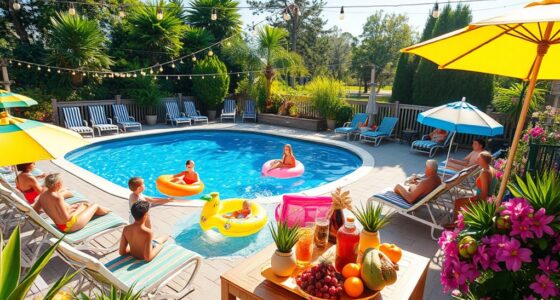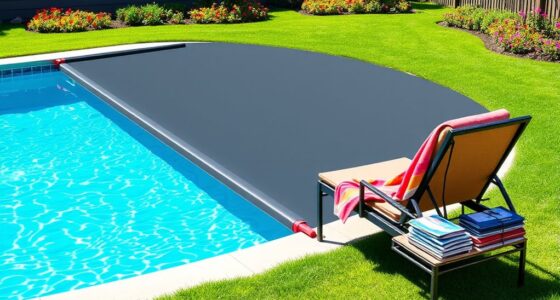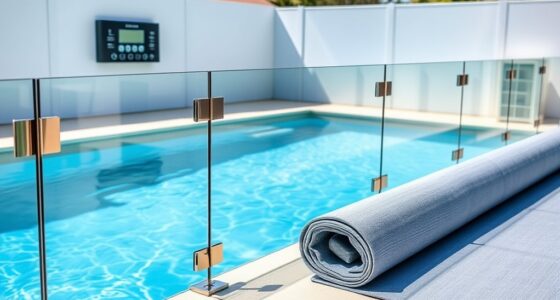After heavy rain or flooding, you should first inspect your pool for structural damage, check water levels, and make sure safety devices are intact. Remove debris promptly and clean the surface thoroughly to prevent algae and contamination. Test and balance the water chemistry, adjusting pH and sanitizer levels as needed. Check and service equipment, and manage water drainage to avoid hydrostatic pressure. To learn more about safe reopening steps, keep going for detailed guidance.
Key Takeaways
- Conduct a thorough visual inspection for structural damage, leaks, and electrical issues before re-engaging pool equipment.
- Remove debris from the surface, walls, and surrounding area to prevent contamination and protect filtration systems.
- Test and adjust water chemistry, including pH, alkalinity, and sanitizer levels, to restore safe swimming conditions.
- Manage water levels carefully, avoiding full drainage to prevent hydrostatic pressure damage, and inspect drainage and relief valves.
- Ensure safety devices are operational, secure electrical wiring, and prepare equipment on elevated platforms for future flood protection.
Assessing Pool Structural Integrity and Water Levels

After heavy rain or flooding, it’s essential to promptly assess your pool’s structural integrity and water levels before attempting to reopen it. Begin by visually inspecting the walls, floor, and tiles for cracks, bulges, or displacement, which indicate structural damage. Check for leaks, visible as wet spots or unexplained water loss, and assess the surrounding fencing for stability to prevent accidents. Look for signs of soil shifting or settlement, such as uneven surfaces or cracking around the pool edge. Keep the water level at a safe point—typically halfway up the skimmer—avoiding complete draining if groundwater is high. Remember, rising groundwater increases hydrostatic pressure, risking pool lifting or damage. If you notice significant issues, consult a professional before proceeding.
Removing Debris and Cleaning the Pool Surface

Once you’ve assessed your pool’s condition after heavy rain, it’s time to remove debris and clean the surface. Use a skimmer net or leaf rake to clear floating leaves and branches, and immediately empty skimmer baskets to keep water flowing smoothly. Removing debris promptly helps protect your filtration system and prepares your pool for proper chemical balancing. Regular debris removal prevents clogging, which can impair circulation and filtration efficiency. Incorporating grocery savings strategies can also help maintain your pool equipment by ensuring budget-friendly maintenance supplies.
Debris Removal Techniques
Removing debris from your pool surface promptly after heavy rain or flooding is essential to maintain water clarity and prevent damage. Use leaf nets or flat skimmers attached to telescopic poles to physically lift leaves, twigs, and floating debris. Regularly clean skimmer and pump baskets to prevent clogs, ensuring your filtration system works efficiently. Use a pool brush to dislodge dirt, algae, and debris from walls, steps, and benches, making removal easier and reducing algae growth. Skim the water surface frequently with fine mesh skimmer nets during and after rain to catch floating debris before it sinks. Clear debris from the pool deck and hose it down to prevent recontamination. Timely debris removal helps keep your pool clean, balanced, and ready for safe use.
Post-Storm Pool Cleaning
Begin your post-storm cleaning by thoroughly removing all visible debris from the pool surface. This clears the way for effective cleaning and prevents debris from clogging filters. Next, focus on these key steps:
- Empty the pump strainer and skimmer baskets to maintain peak filtration.
- Inspect the pool surfaces for damage, scratches, or algae growth that may have occurred during the storm. Regular maintenance helps prevent long-term issues.
- Ensure the circulation system is operational to facilitate cleaning efforts and promote water quality.
- Prepare your cleaning tools—such as a pool brush, vacuum, and suitable cleaning agents—for efficient removal of dirt and contaminants. Proper equipment ensures effective debris removal and prevents further contamination. Using the right tools, like a skimmer net, can make debris removal quicker and more thorough.
Brushing the walls, steps, and floor helps dislodge silt, algae, and dirt, making vacuuming more effective. Proper preparation and cleaning set the stage for clear, healthy water.
Balancing Water Chemistry After Flooding

After a flood, you need to test your water chemistry to identify imbalances caused by rain and runoff. Adjust the pH to around 7.4–7.6 and stabilize alkalinity to prevent fluctuations that can damage your pool. Replenish sanitizer levels to ensure proper disinfection and keep your pool safe for swimming. Monitoring chemical levels regularly is essential during this process to maintain a healthy and clear swimming environment. Additionally, understanding the importance of contrast ratio can help you evaluate your pool lighting and ensure optimal visibility during nighttime swims.
Test Water Chemistry
How can you guarantee your pool’s water remains safe and balanced following heavy rain or flooding? First, test the water chemistry immediately. Focus on these key areas:
- Chlorine Levels: Use reliable test kits to measure chlorine, then perform super chlorination to restore proper sanitizer levels, retesting after 8-24 hours. Proper chlorine levels are essential to prevent algae and bacterial growth after contamination. Regular testing can help detect fluctuations early.
- Calcium Hardness: Check calcium levels to prevent corrosion, adding increasers if levels fall below 200 ppm. Maintaining balanced calcium levels is vital for protecting pool surfaces and equipment.
- Cyanuric Acid: Measure stabilizer levels to protect chlorine from UV degradation, adjusting as needed. Ensuring adequate stabilizer levels can extend the effectiveness of your chlorine.
- Phosphates: Test for phosphates to assess algae risk, applying removers if levels are high. Testing water regularly after heavy rain is crucial for maintaining overall water quality and ensuring the longevity of your pool equipment. Monitoring water chemistry consistently helps prevent long-term issues and keeps the water safe for swimming.
Adjust Ph and Alkalinity
Have you noticed your pool’s pH and alkalinity levels fluctuate unpredictably after heavy rain or flooding? Rainwater is naturally acidic, which lowers both pH and total alkalinity. Flood runoff introduces chemicals, minerals, and pollutants that further disrupt water balance. A low alkalinity reduces your pool’s buffering capacity, making pH swing easily and risking corrosion or scale buildup. Imbalanced pH—either too low or too high—can cause skin and eye irritation, degrade surfaces, and damage equipment. To fix this, first measure alkalinity, then adjust it with baking soda if it’s too low or muriatic acid if it’s too high. After stabilizing alkalinity, test pH and adjust gradually using soda ash or acid. Proper balancing ensures safe, clear water and protects your pool’s integrity. Additionally, understanding how water chemistry affects pool maintenance can help prevent long-term issues.
Replenish Sanitizer Levels
Heavy rain and flooding can substantially reduce your pool’s sanitizer levels, making it easier for bacteria and algae to thrive. To restore proper sanitation, you need to replenish sanitizer levels effectively. Here’s what to do:
- Perform superchlorination (shocking) with liquid or granular chlorine, adjusting dosage based on contamination severity. Proper dosing is crucial to effectively eliminate organic contaminants.
- Run your pool pump continuously at high speed during and after shock treatment to ensure even distribution.
- Wait 12–24 hours of filtration, then test chlorine levels, aiming for 2–4 ppm free chlorine.
- Regularly monitor sanitizer levels and chloramine buildup, repeating shock treatments as needed to maintain safe, effective water chemistry. Additionally, maintaining proper water chemistry balance helps prevent future issues.
This process helps eliminate organic contaminants, restores sanitizer power, and ensures safe swimming conditions after flooding.
Checking and Servicing Pool Equipment and Filters

After a flood or heavy rain, it’s essential to thoroughly inspect your pool equipment and filters before restarting your system. First, check the pump, pipes, and filter for cracks or damage, and look for water intrusion or corrosion in electrical connections and junction boxes. Watch for wet spots or pooling water around the equipment pad, which could indicate leaks. Examine the heater, chlorinator, and automation systems for signs of water exposure, and document any damage for insurance or repair purposes. Turn off all breakers before servicing, and only reset tripped breakers at the main panel; if they won’t reset, call an electrician. Clean or backwash the filter, inspect the media, and remove debris from pump baskets. Make certain everything is dry, operational, and safe before restoring power. Additionally, water contamination from flooding can affect the integrity of your equipment, so consider testing the electrical components for moisture and corrosion to prevent future issues. It’s also wise to verify that your filter media is still effective and not compromised by debris or water damage to ensure your pool remains clean and safe.
Managing Water Drainage and Preventing Hydrostatic Damage

Managing water drainage after heavy rain or flooding is essential to prevent hydrostatic damage to your pool. High groundwater levels can exert significant pressure on the pool shell, risking floatation or structural damage. To do this effectively: 1. Wait until the water table recedes before draining, especially if the pool is empty, to avoid floating or cracking. 2. Use siphoning or submersible pumps to remove excess water safely, avoiding illegal or environmentally harmful methods. 3. Drain only partially—just below the skimmer level—to reduce hydrostatic pressure without risking damage. 4. Regularly check for and operate the pool’s hydrostatic relief valve, ensuring it functions properly during drainage. Monitoring groundwater levels is crucial to determine the right time to drain. Employing hydrostatic relief valves as part of your pool’s design helps prevent damage during water level fluctuations. Following these steps helps protect your pool’s integrity while managing water levels after storms.
Restoring Pool Safety and Preparing for Use

Ensuring your pool is safe to use following a flood is essential before resuming regular operation. Start by shutting off all electrical power to prevent hazards, and inspect for structural damage like cracks or displaced tiles. Keep children and pets away until debris and contaminants are cleared. Verify that safety devices—fencing, gates, alarms—are intact and operational. Use PPE during cleaning, removing debris, and disinfecting surfaces with chlorine solutions, avoiding mixing chemicals. Test water chemistry after cleaning, adjusting pH and chlorine levels, and use clarifiers to clear murky water. Consult professionals to inspect submerged equipment and plumbing for damage. Incorporating dog names that reflect the breed’s personality can also help create a welcoming environment for your furry friends once the pool is ready.
Implementing Preventative Measures for Future Storms

To protect your pool from future storms, implementing effective preventative measures is essential. Start by elevating and securing your equipment:
- Raise pumps, heaters, and filters above flood levels, using sturdy, anchored platforms like concrete blocks. Elevating equipment reduces the risk of flood damage and keeps the system functioning properly during storms. Consider using proper drainage solutions around your equipment area to divert water away effectively.
- Properly extend and seal pipes, installing check valves to prevent back siphoning.
- Secure electrical wiring in conduit, mounting it above flood-prone areas.
- Conduct frequent inspections of these platforms to ensure ongoing stability and protection.
Additionally, use advanced pool covers made from marine-grade, watertight materials with smart anchoring systems. Employ flood barriers, sandbags, and custom flood panels to physically block floodwaters. Regularly clear drainage points and lower water levels slightly before storms, and keep sump pumps and storm drains well-maintained.
Frequently Asked Questions
How Soon Can I Safely Swim After Heavy Flooding?
You shouldn’t swim until the water is thoroughly tested and cleared by local health authorities, which can take several days after flooding. Wait at least 48 hours after heavy rain, but extend that period if flooding occurred, until water looks clear and calm. Always confirm safety with official advisories or water testing kits before jumping in. Never swim in floodwaters or pools that haven’t been properly cleaned and disinfected.
What Signs Indicate Pool Liner or Wall Damage?
You’ll notice signs of damage if the liner wrinkles, bubbles, or tears appear, especially if they weren’t there before. Watch for water loss over a day, cloudy or murky water, and gaps where the liner disconnects from the track. Cracks, discoloration, or rust on the walls, along with sinking or unstable decking, also signal potential damage. If you hear gurgling sounds or see debris buildup, it’s time to inspect further.
Can I Use Pool Chemicals Immediately After a Flood?
Did you know that improperly handled pool chemicals can cause dangerous reactions? You shouldn’t use pool chemicals immediately after a flood. First, remove debris and clean the pool thoroughly. Test water chemistry and adjust pH and alkalinity before adding chemicals. Store or dispose of any contaminated chemicals safely. Handling floodwaters with care is essential—wait until your water is balanced, clean, and safe to guarantee effective treatment and your safety.
How Do I Prevent Algae Growth Post-Storm?
To prevent algae growth after a storm, you should maintain proper water chemistry by testing and balancing pH, alkalinity, and sanitizer levels daily. Run your pump continuously for 24–48 hours to improve circulation, and clean the filter regularly. Remove debris promptly, brush the pool walls, and vacuum the surface. Shocking the pool and adding algaecide also help prevent algae, especially if the water looks cloudy or has high nutrient levels.
Is It Safe to Turn on Pool Equipment After Submersion?
Only turn on your pool equipment after a professional inspects it—statistics show that 70% of electrical failures after flooding are caused by improper re-energizing. You shouldn’t re-energize submerged equipment because water can cause corrosion, short circuits, or fires. Always shut off power at the main breaker, wait for a licensed electrician to inspect and dry components, and verify safety before restoring power. This approach keeps you safe and prevents costly damage.
Conclusion
As you finalize your pool’s reopening, remember that even small overlooked details can hide hidden dangers. Will you catch every crack, every debris, every water imbalance before inviting friends back in? With keen eyes and thorough checks, you’ll uncover what’s needed to guarantee safety and longevity. But the true test lies ahead—will your pool stand strong against the next storm? Stay vigilant, and your oasis will be ready when the skies clear.










